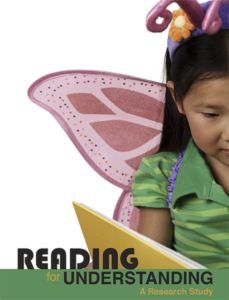 Reading comprehension is a challenge to many children in the United States. In fact, 1 out of 3 fourth-graders and 1 out of 4 eighth-graders struggle to comprehend what they read; in turn, this poses a threat to their future educational and employment success.
Reading comprehension is a challenge to many children in the United States. In fact, 1 out of 3 fourth-graders and 1 out of 4 eighth-graders struggle to comprehend what they read; in turn, this poses a threat to their future educational and employment success.
The U.S. Department of Education Institute of Education Sciences (IES) recognizes that we must learn much more about reading comprehension. In 2010, it invested $100,000,000 in the Reading for Understanding (RFU) consortium to address such questions as:
- How does reading comprehension develop?
- Why do so many children struggle to comprehend what they read?
- How can we improve comprehension instruction across the grades?
The multi-disciplinary LARRC research team leading this project include the following principal and co-investigators:
Arizona State University (ASU): Shelley Gray (PI), Adelaida Restreppo
Florida State University (FSU): Hugh Catts (PI)
Lancaster University, United Kingdom (LU): Kate Cain (PI)
Massachusetts General Hospital Institute of Health Professions (MGH IHP): Tiffany Hogan (PI)
The Ohio State University (OSU): Laura Justice (LARRC RFU PI), Richard Lomax, Ann O’Connell, Jill Pentimonti, Steve Petrill, Shayne Piasta
University of Kansas (KU): Hugh Catts (PI), Mindy Bridges, Diane Nielsen
University of Nebraska-Lincoln (UNL): Tiffany Hogan (PI), Jim Bovaird
The LARRC is conducting the 5-year multi-state study focused on comprehension development and understanding for children ages 4 to 8 years of age. Foci include:
- To understand the role of language skills in reading comprehension, with a focus on such skills as grammar, vocabulary, and narration.
- To understand risk factors that make reading comprehension particularly difficult for some children, with a focus on those that can be changed through instruction and intervention.
- To develop effective ways to improve reading comprehension, with a focus on developing high-impact practices that can be readily employed at relatively low costs by large numbers of preschool to grade 3 teachers.
Download the LARRC Informational Brochure
Study 1 (Years 1 – 5) – Longitudinal Study
Examining reading comprehension: language bases, cognitive predictors, child- and environmental-level influences.
The aims of Study 1 are:
- To identify grade-related differences in the relative contribution of lower- and higher-level language skills to children’s listening and reading comprehension in PK through G3;
- To determine the nature of the prospective relationship between children’s lower- and higher-level language skills in the early grades and reading comprehension in G3; and
- To determine the extent to which select child- and environmental-level attributes are positive, prospective predictors of reading comprehension and to determine whether these moderate the relations between language skills and reading comprehension.
Study 2 (Years 1 – 3) – Teacher Trials and Pilot Study
Development of language-based comprehension intervention.
The aims of Study 2 are:
- To define and develop multiple instantiations of language-based comprehension intervention (two instantiations x 5 grade levels) that will increase language development, background knowledge, and listening and reading comprehension in PK through G3 pupils;
- To improve the interventions through a systematic and iterative process involving feasibility trials and pilot testing to arrive at two fully manualized instantiations of language-based comprehension interventions for each grade level, ready for controlled trials in Study 3; and
- To develop valid and reliable measures of treatment fidelity for each of the instantiations that fully represents the key features of change.
Study 3 (Years 4 – 5) – Randomized Controlled Trial
Impacts of language-based comprehension instruction.
The aims for Study 3 are:
- To determine the extent to which two instantiations of language-based comprehension intervention impacts the quantity and quality of language and reading instruction;
- To determine the extent to which two instantiations of language-based comprehension instruction impacts lower- and higher-level language skills (PK-G3), listening comprehension (PK-G3), reading comprehension (K-G3), and background knowledge (PK-G3) of children relative to the business-as-usual reading curriculum.
- To determine potential teacher- and child-level moderators of intervention impacts.
